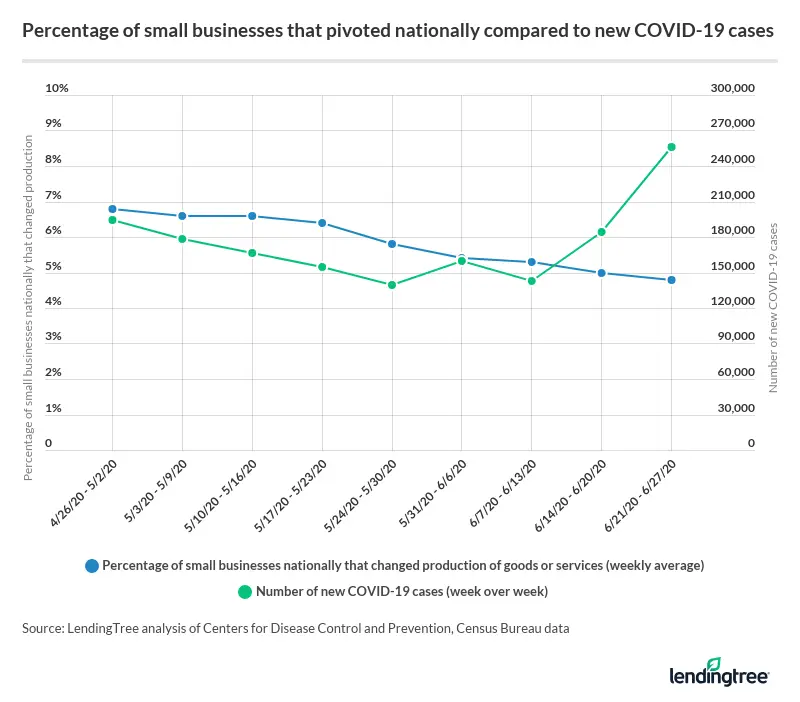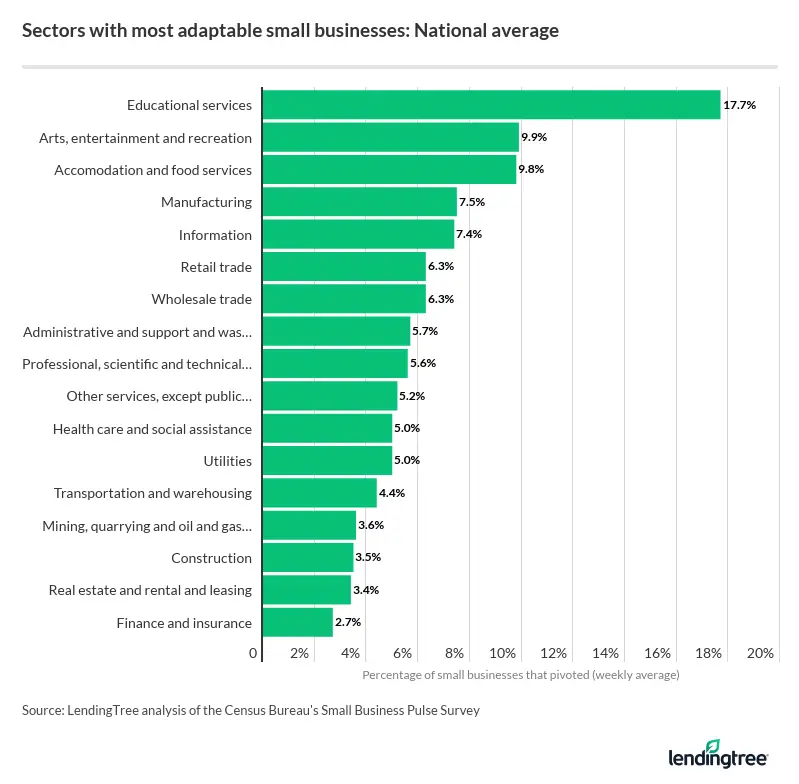States With Most Adaptable Small Businesses During Coronavirus
Almost a third of small business owners and managers reported in April that operations had halted because of the coronavirus crisis. However, LendingTree researchers found that from late April to late June, a weekly average of almost 6% of small businesses reported switching production to other goods and services, most heavily in education and the arts. Keep reading to find out more about how your state has adapted amid the pandemic.
Key findings
- The weekly average of small businesses across the U.S. that reported switching production was 5.9% from April 26 to June 27, the full period of the nine-week survey.
- The District of Columbia had the highest weekly percentage of small businesses pivoting during that nine-week period, with 12.9% of small businesses shifting to the production of other goods and services. D.C. was followed by Hawaii, Alaska, New Mexico and Delaware at 12%, 10.6%, 10.4%, and 10.1%, respectively.
- Michigan, Ohio, Arizona, Oregon and Tennessee pivoted the least, with 6.3%, 6.5%, 6.7%, 7% and 7%, respectively, of small businesses reporting shifting production in a given week.
- The weekly national average for small businesses reporting shifting production was higher in certain sectors, including educational services (17.7%), arts, entertainment and recreation (9.9%), accommodation and food services (9.8%), manufacturing (7.5%) and information (7.4%).
Comparing small business pivots to new coronavirus cases
From April 26 to May 2, 6.8% of small business respondents nationally reported switching their production to other goods and services, the highest rate of change in the nine-week period. The weekly national average gradually decreased after the week of May 10 to 16, reaching 4.8% in the final week of the survey. The average for the nine-week period was 5.9%.
Meanwhile, the U.S. saw 193,990 new coronavirus cases from April 26 to May 2, the second-highest week-over-week increase among the survey’s nine-week period. It wasn’t until the survey ended the week of June 21 that cases drastically rose again in the U.S. That week, the U.S. saw 256,146 new cases. By this point, though, many small businesses had already adapted to COVID-19, so fewer still needed to pivot.
Meanwhile, the U.S. saw 193,990 new coronavirus cases from April 26 to May 2, the second-highest week-over-week increase among the survey’s nine-week period. It wasn’t until the survey ended the week of June 21 that cases drastically rose again in the U.S. That week, the U.S. saw 256,146 new cases. By this point, though, many small businesses had already adapted to COVID-19, so fewer still needed to pivot.

5 states with most adaptable small businesses
Of the five states with the highest weekly percentage of small businesses that pivoted their production to other goods or services amid the coronavirus, the top three adapted the most in the first or second week of the survey, in late April and early May.
No. 1: District of Columbia
The District of Columbia had the highest weekly percentage of small business respondents that reported pivoting production — in fact, 12.9% of small businesses in D.C. switched production to other goods or services in the first week of the survey (April 26 to May 2). In that same period, 77.3% of D.C. small businesses reported a decrease in operating revenues.
By the final week of the survey, a drop in revenue (not including financial assistance or Paycheck Protection Program funding) was cited by just 48.7% of D.C. businesses, which could suggest that early adaptations were successful.
No. 2: Hawaii
In the second week of the survey (May 3 to May 9), 12% of Hawaii small business respondents adapted and began to produce other goods or services. More than 11,000 small businesses in the state were getting federal aid at the end of April, but many small businesses still needed to adapt their business models because of the pandemic.
During this period, 71.5% of Hawaii small businesses reported a decrease in revenue.
No. 3: Alaska
In the Last Frontier, 10.6% of small businesses reported pivoting their production in the first week of the survey, adapting quickly.
In fact, 65.5% of Alaska small businesses reported revenue drops in the first week, which was lower than the national average at 74%. Alaska has a high proportion of highly vulnerable sectors:
- Accommodations
- Food service
- Transportation
- Warehousing
No. 4: New Mexico
New Mexico small businesses saw their highest percentage of pivots in the fifth week of the survey (May 24 to May 30), at 10.4%. Past the halfway point of the survey, 42.9% of small businesses nationally were found to be largely negatively impacted by the pandemic, so small businesses in the state took time to assess the impact before adapting their business approach.
In that fifth week of the survey, 58.4% of New Mexico small businesses saw a decrease in revenue. New Mexico is especially struggling in the hospitality, tourism and restaurant industries.
No. 5: Delaware
In the fourth week of the survey (May 17 to May 23), 10.1% of small businesses in Delaware thought on their feet and changed their business models to better withstand the pandemic. At this point, 48.8% of small businesses saw a decrease in their revenues.
Biggest pivots in states most affected by coronavirus cases
The four U.S. states with the highest populations had to adapt and pivot to the production of other goods or services in certain sectors. These states have also seen the most coronavirus cases.
California
Small businesses surveyed in California reported pivoting in the most sectors out of any other states that responded to the survey. But the state has also seen more than 620,000 cases, the most in the U.S.
In the Golden State, 24.2% of small businesses in educational services adapted each week, on average. Other noteworthy pivots were seen in:
- Arts, entertainment and recreation: 16%
- Accommodation and food services: 11.2%
- Administrative and support and waste management services: 10.9%
Florida
Florida has seen the second-most coronavirus cases — more than 570,000 — behind California. Small businesses have had to make major pivots — weekly, on average — as a result, mainly within:
- Manufacturing: 14%
- Accommodation and food services: 12.7%
- Retail trade: 11.8%
Texas
Small businesses in Texas have made major pivots in:
- Accommodation and food services: 16.1%
- Manufacturing: 12.1%
- Other services, except public administration: 11.6%
Texas has seen more than 560,000 cases, which is third among U.S. states.
New York
In New York, which has reported more than 430,000 coronavirus cases, 16.3% of survey respondents in accommodation and food services reported pivoting production each week, on average. New York small businesses also made noticeable changes in:
- Manufacturing: 10.2%
- Professional, scientific and technical services: 6.9%
- Wholesale trade: 6.6%
Sectors that pivoted the most nationally
The top sectors with the most adaptable businesses rely heavily on consumers being present:

As of July 31, only 8.1% of PPP funding for small businesses had gone to small businesses in accommodation and food services. That is followed by:
- 2.3% to educational services
- 1.6% to arts, entertainment and recreation
Methodology
LendingTree researchers analyzed responses from the U.S. Census Bureau’s weekly Small Business Pulse Survey from April 26 to June 27. Because there weren’t responses from each state each week, we ranked the states that pivoted production the most by looking at the week where their responses were their highest percentage. Mississippi, Nebraska, North Dakota, Rhode Island, South Dakota, West Virginia and Wyoming didn’t respond, so they weren’t included. We averaged the nine weeks to reach the overall rate of small businesses that pivoted production of goods or services. Coronavirus case information is via The New York Times, as of Aug. 17.
Compare business loan offers

